Modifications
We are no longer building saddle trees, but we have two videos about how Western saddles fit horses available on our westernsaddlefit.com website.
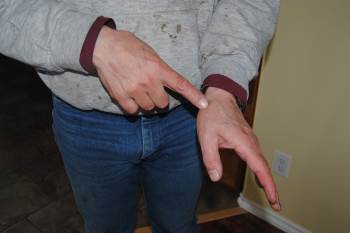 |
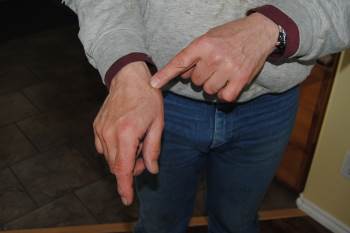 |
It’s been interesting around here the last few weeks. Rod has been having problems with his hands for a while now, and on March 13th, he was diagnosed with “relatively advanced degeneration of the first carpometacarpal joints bilaterally” which, in English, means pretty severe arthritis at the base of both thumbs. So we have been doing a lot of thinking and figuring and changing things in order that Rod can continue to build trees with some level of comfort. We’re writing this post to hopefully give others ideas or even just think about what they can do to help preserve their hands from suffering (pun intended) the same fate.
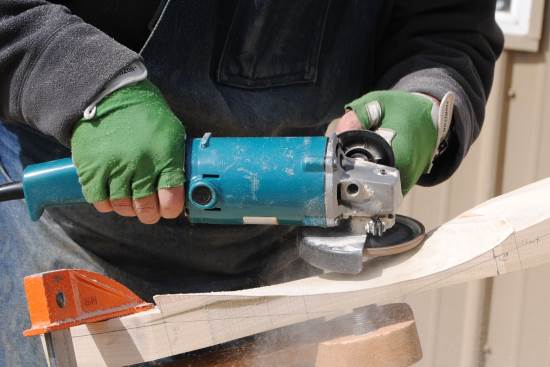
One of the first things we keyed in on that may have caused the damage was the vibration from the side grinder which he has used many hours a week for nineteen years. He has always worn anti-vibration gloves whenever he has used the grinder.
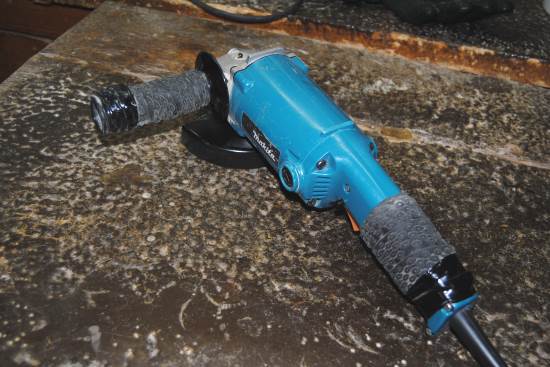
and when anti-vibration wrap came out, he got some of that as well and has had it on both handles of both grinders since. But obviously, it wasn’t enough.
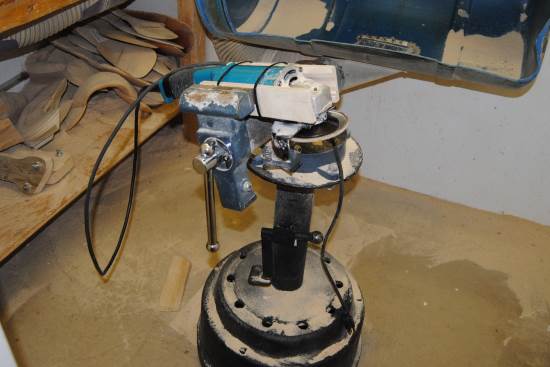
After the diagnosis, when we knew we would have to make more permanent changes, we tried this. Rather than taking the grinder to the wood, why not take the wood to the grinder? That way the stand takes the vibration, not Rod’s hands. Rod doesn't actually use this now, as he has found better ways, but this experiment sure taught us how much vibration Rod’s hands have been taking over the years. When turned on, the whole stand shakes. The balls on the ends of the vice tightening handle would unscrew and fall off within two minutes. Yeah… not good...
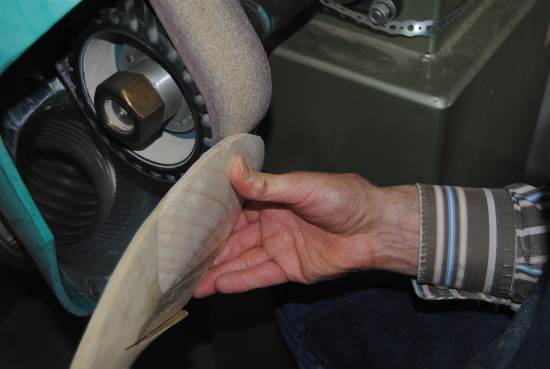
Rod has always used the grinder to do most of his carving, only using the sander for the finer work before the rasp and sandpaper. But we know of other tree makers who use their sander a lot more, so Rod tried that. It worked, but it took more time. And in some ways it wasn’t a lot better, as he needed to put a lot of pressure on the wood – with his thumbs. Extending the thumb back is what is really painful – and therefore obviously contributing to the problem – and that was the position it was in for a lot of the time when doing the bars this way.
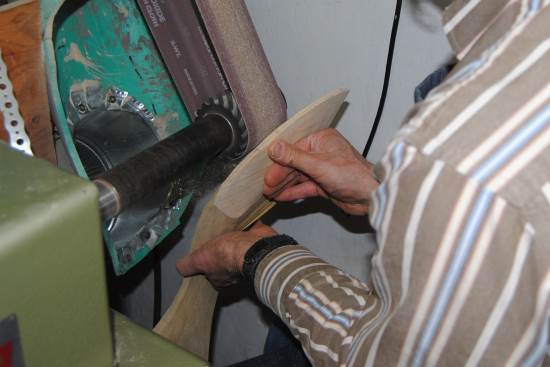
Even trying to modify his hand position still meant there was a lot of pressure on his thumbs.
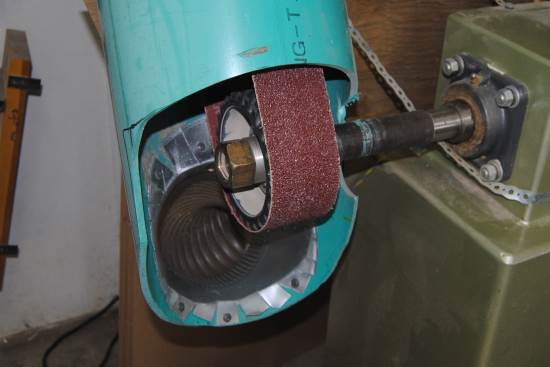
So… he ordered a coarser grit sandpaper. He has always used 50 grit, which was about as coarse as he could get back when he ordered his last sanding belts many years ago. Now, after a lot of time spent on the internet and phone tracking down a supplier, he was able to get 24 grit. That cuts down on the amount of time he needs to do each section and also the amount of pressure he needs to use to hold the wood. We're gaining…
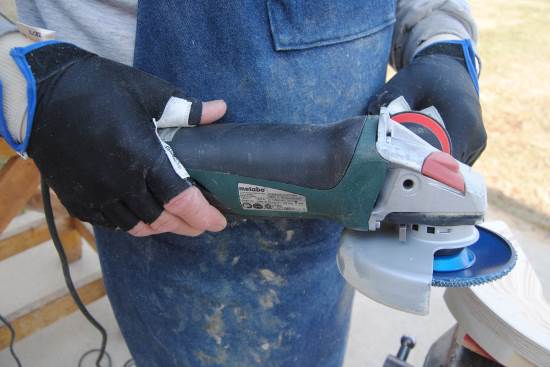
Then Rod came in one day and said “We should Google grinder vibration.” Duh… Falling into the category of “things we wish we had known years ago” was the difference in vibration between different grinders. While Makitas are good grinders and not the worst for vibration by any means, they are far from the best. More time on the net and the phone and we tracked down a couple of Metabos.
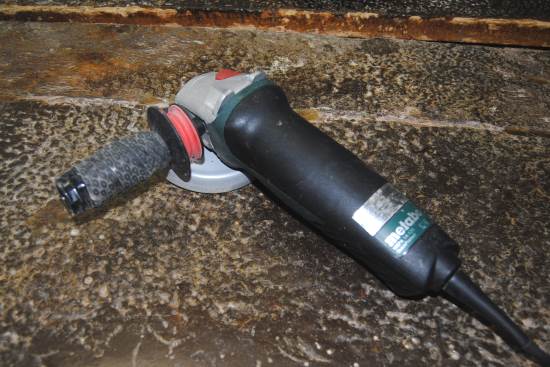
They have half the vibration of the Makitas, by stats. Less from the machine itself, an anti-vibration grip up front and a larger, more ergonomic grip at the back. (And yes, we use the anti -vibration wrap on it too…)
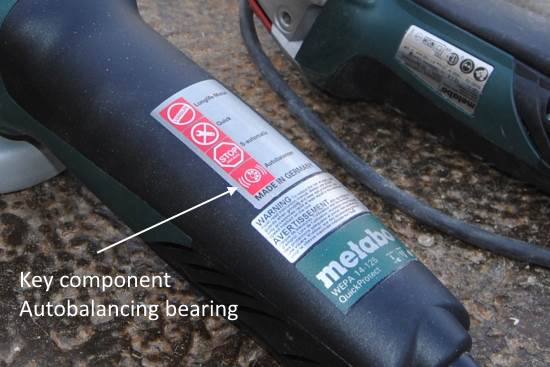
But most importantly, it has an auto-balancing bearing right under the disc. Cutting discs and things like that are pretty symmetric. But our carbide grinding discs?? Not so much, especially when they get filled with sawdust in some sections and not others. Having something that will minimize the shaking from an unevenly weighted disc must cut down vibration a lot more than the stats say. And Rod really notices the difference.
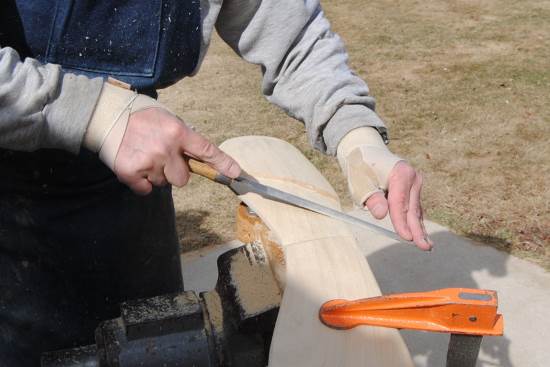
While we were researching and changing all these things, we also made appointments to see a couple of occupational therapists. We took in tools, pictures and videos of Rod working to show them what he does, how he holds his hands, etc. so they could give us advice on what else we could do to try to extend Rod’s career as a tree maker. Turns out, there are a few things.
One of the first things they suggested was thumb supports specific to this condition. We ended up getting a couple of types to see which work best, and so far these are the ones that Rod likes the best. They have stays on both sides of the thumb to give moderate support, but they aren’t totally rigid, so he can still move his thumbs when needed. The supports hold them in a neutral position unless he actively moves them and probably take some of the pressure off at times as well. So now we have “thumbs” to add to the “ears” (hearing protection), “eyes” (safety glasses) that get worn around the shop.
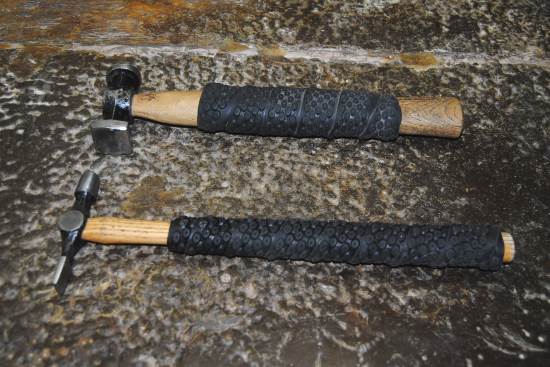
As far as modifying tools etc, they explained to us that large surface areas distribute pressure better than small ones, (Hmm… seems like I’ve heard that principle before somewhere…) so the larger the handles and tools – within reasonable limits - the easier it is on the hands to hold and use. The idea is to build up the tools to a size that is comfortable. Too large and it extends the thumbs too much, so the plan was to try it and see what felt good. This meant more anti-vibration wrap, this time around hammer handles. It makes the diameter larger and also less slippery so Rod doesn’t have to hold them as hard and it also cushions the bounce from the hammer hitting the metal nail set hundreds of times day. Rod says he can really feel the difference it makes.
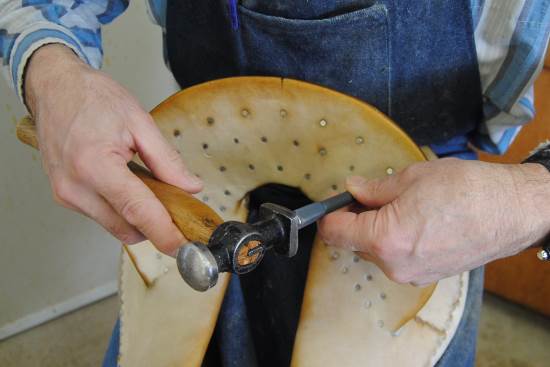
One of the other things that is really hard on this joint is the pinching action of holding small diameter objects, especially if you have to hold them tightly. We had taken the nail set in when we went to see the OTs. He said “I can help you with that”,
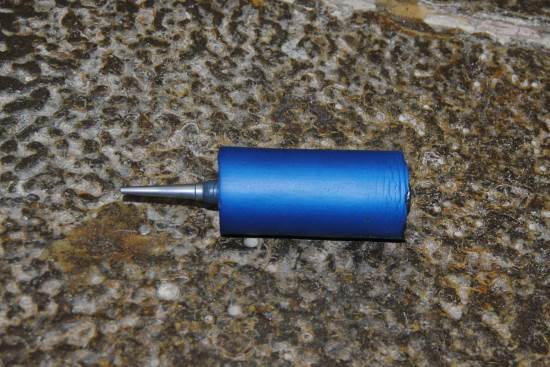
and gave us this section of foam tubing. The nail set is tightly held inside it, and that extra diameter makes a world of difference to the amount of pressure you have to exert to hold it steady. The larger diameter can make seeing difficult sometimes, but Rod can work around that. The pain reduction is significant with this little trick. Sure makes us wonder if these types of things would be helpful for our saddle making customers who spend hours and hours holding small diameter tools while they hit them with hammers of various types.
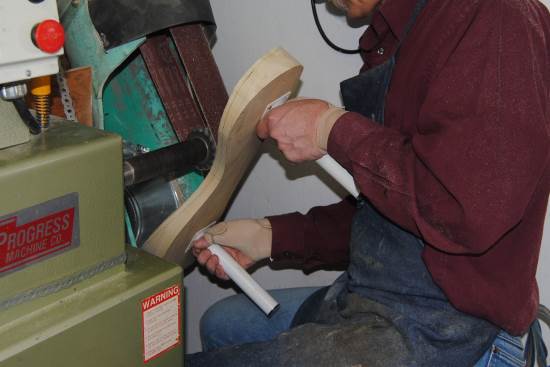
Following along with this idea of holding things more ergonomically, we got thinking about using the sander. Was there some sort of system we could come up with so Rod didn’t have to hold the bars with his thumbs extended when he was working on them? One day, he flattened the feet on a couple of old horns, used screws to attach them to the bar he was working on, and voila, it worked!! He could hold the bars much more easily and still have good control in shaping them. Since horns aren’t the most comfortable thing to hang onto, we went looking for what else we could use. Short table legs, of course!!
Two small screws per leg holding them to the bottom of the bars hold them firmly enough to do the top of the bar, and all the wood the screws attach to is removed when the bottom is done. Then Rod screws them into the same area where he attaches the fork and cantle while he does the bottom of the bars. This worked well, but could it be better?
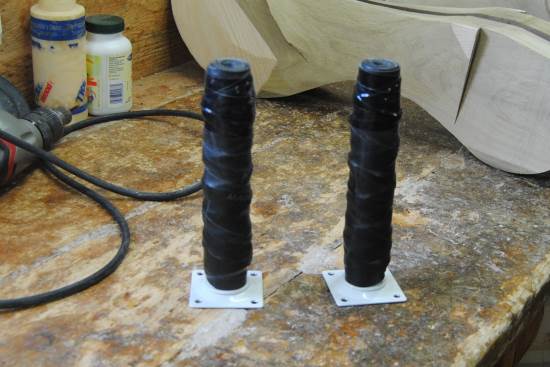
Yup. Rubber wrapped around the legs makes them larger diameter (that surface area thing again…) and less slippery to hold on to. So far, so good. But I’m still figuring here. We’ll see if anything else changes…
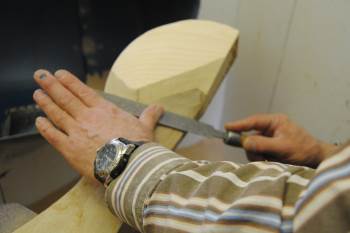 |
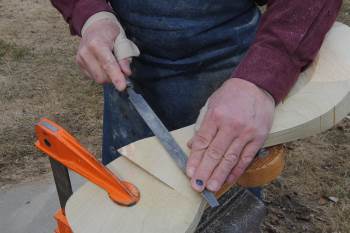 |
But it isn’t just modifying the tools that will make a difference. It is learning to use his hands in a different way that will also help. This is harder to do. One of the OTs suggested that Rod imagine that he had no thumbs to use for a few weeks and see what he could change. And turns out he can do a lot of things differently – once he tries and thinks about changing. “It’s like raindrops”, one of the OTs told us. “Individually they don’t make much difference, but put a lot of them together, they can make a flood.” Small things matter…
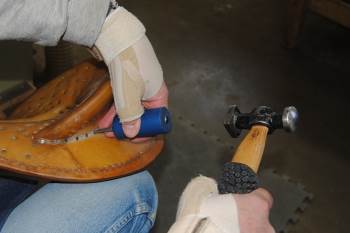 |
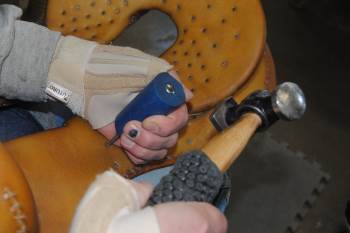 |
So there are a variety of ways he is trying out to hold things. Things like holding your hand in a cupped position around things, rather than using fingers and thumb. The more pressure he can put on the palm or the fingers as a group rather than the tips of fingers and thumbs, the better. Sometimes one works, sometimes another. Sometimes he can’t use the ideal method. Sometimes he can. It takes more time right now, but hopefully he will be able to rebuild his muscle memory in different ways. Retraining after nineteen years of doing things the same way is hard!!
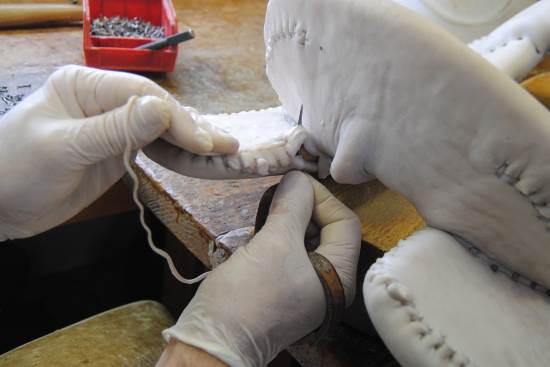
Once we had the woodwork going better, Rod really noticed how much the rawhiding was causing pain. He tried wearing the splints when rawhiding but junked that idea after just one tree. His hands hurt a lot more with them than without them. We figured that it was because he still had to make those strong pinching actions when holding nails and pulling the needle through the rawhide, and he was fighting the splints to do it, making his thumbs work extra hard. So, no “thumbs” when he is rawhiding.
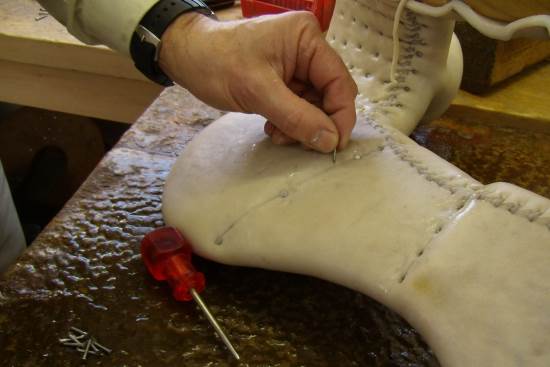
One of the things he found the most painful sounds the simplest – picking up a nail and holding it in place to hammer it in. First try was to use his awl to poke holes for the nails. Then he only had to pick them up and put them in place so he didn’t need to hold them as tightly. But there had to be a better way. Turns out I didn’t do surgery for a bunch of years for nothing. I know that using tools with a scissors kind of grip can give you a lot of precision without your fingers being right there. But he didn’t like the hemostats I loaned him. He still had to use his thumb to grip and that hurt. So that was no good.
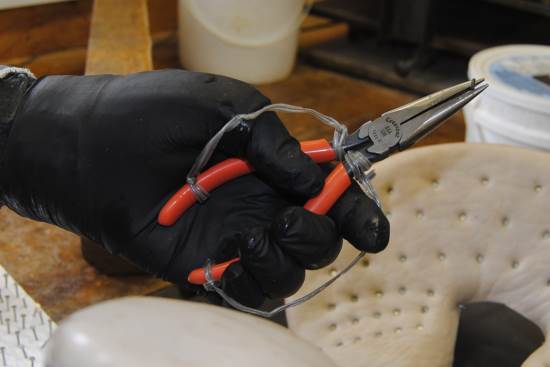
But what about needle nose pliers? I just used long twist ties to make handles for his fingers and thumb. That way the pliers would stay in his hand without him having to hold tightly to them, and he could open them up by just opening his hand. It seemed to be something that could work, but how to pick up the nails without a lot of fiddling…
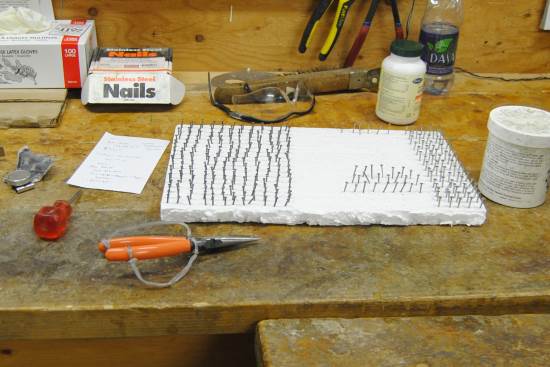
Styrofoam is the answer. So now, the night before Rod rawhides, I set up the nails like this. He can easily grab them with the pliers and hold then them in place with the pliers. He says it isn’t really any slower than him doing the old way, and it doesn’t hurt his hand the same. Do you know that each tree takes between 200 and 220 nails? I didn’t either, but now I do… Even setting up the nails, I get some cramping in the muscles of my thumbs, so I can imagine how something so seemingly simple as picking up a nail time and time again could become impossible eventually. Raindrops…
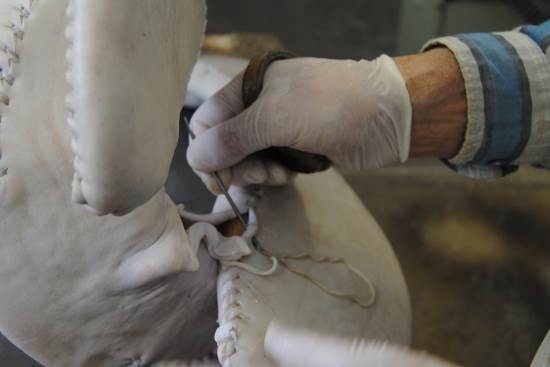
But while my rigged up twist tie system worked fine for Rod’s fingers, the thumb side wasn’t working as well. Besides, I had an idea… One of the OTs kept commenting on the needle and how much pressure it must take to pull it through the rawhide. (Putting it in initially doesn’t take as much hand strength as once it is started he pushes it through with his palm protector.)
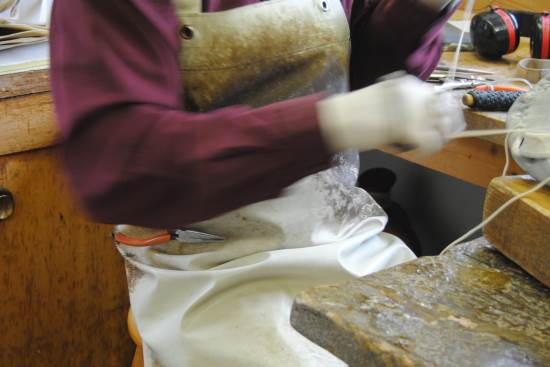
In fact, Rod has another pair of needle nosed pliers that he grabs and uses when the needle is too hard to pull it through by hand. He keeps it on his belt via a magnet. But that is time consuming – put the needle in, grab the pliers, pull the needle through, put them back, pull all the string through, repeat… What if Rod could keep the pliers in his left hand at all times and always use them to pull the needle out? Would that work?
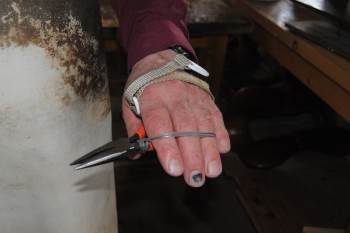 |
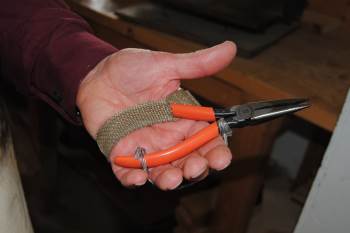 |
That’s where this neat little thingy comes in. It is called a Universal Cuff and is used to help people without hand function. It straps around the hand with Velcro and has a pocket on the palm side into which they can put a spoon or fork so they can eat on their own without having to actually hold the utensil. Spoons, forks, pliers handles – what’s the diff? So this last week he tried it for the first time. It works great!! The pliers are held firmly in Rod’s hand by the cuff. He can open and close them easily with just finger movement.
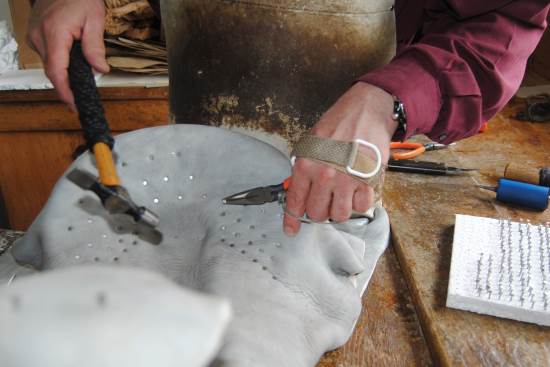
It works for nailing
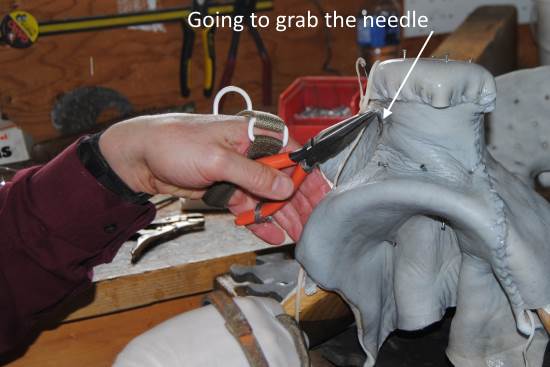
and for a lot of the sewing. Going one way around the bar, the needle is pointed to Rod’s left, so he uses the pliers to pull it through rather than his fingers, as he has always done. Going the other way, the needle is pointed to the right, so it doesn’t work, but he is using his second set of pliers from his belt to pull that way. Yes, it is taking extra time, but if his hands don’t hurt as much, so be it.
So that’s the stage we are at currently in the shop. I’m sure we’ll make more changes yet, and we’ll see how they go and how Rod’s hands do over time. But practically, we have had to face the fact that Rod can’t keep on going the way he has been going. We know his hands won’t hold out for a long time that way, so we have had to make some business changes too.
Currently, our plan is to cut down the number of trees Rod builds a year. Maybe doing less will extend not only the time he can build trees, but the number of trees he eventually can build as well. At least that is our hope. But we still have to live and this is our only real source of income, so with decreased production has to come increased price if we are going to be able to keep building. Not something we want to do, but something we feel we have to do at this time. (And no, we aren’t quitting building trees now. We’ve already heard that rumour has started to circulate.)
It will be interesting in the next while to see how things go. Will enough people still want a Nikkel tree at the increased price to keep us going or not? Will the modifications in the tools and how Rod is using his hands decrease his pain level? What other changes can we make that will improve things even more? We’ll see. But what we do know is that our great God clearly got us into this business, and we can trust Him for our future. He hasn’t failed us yet…
